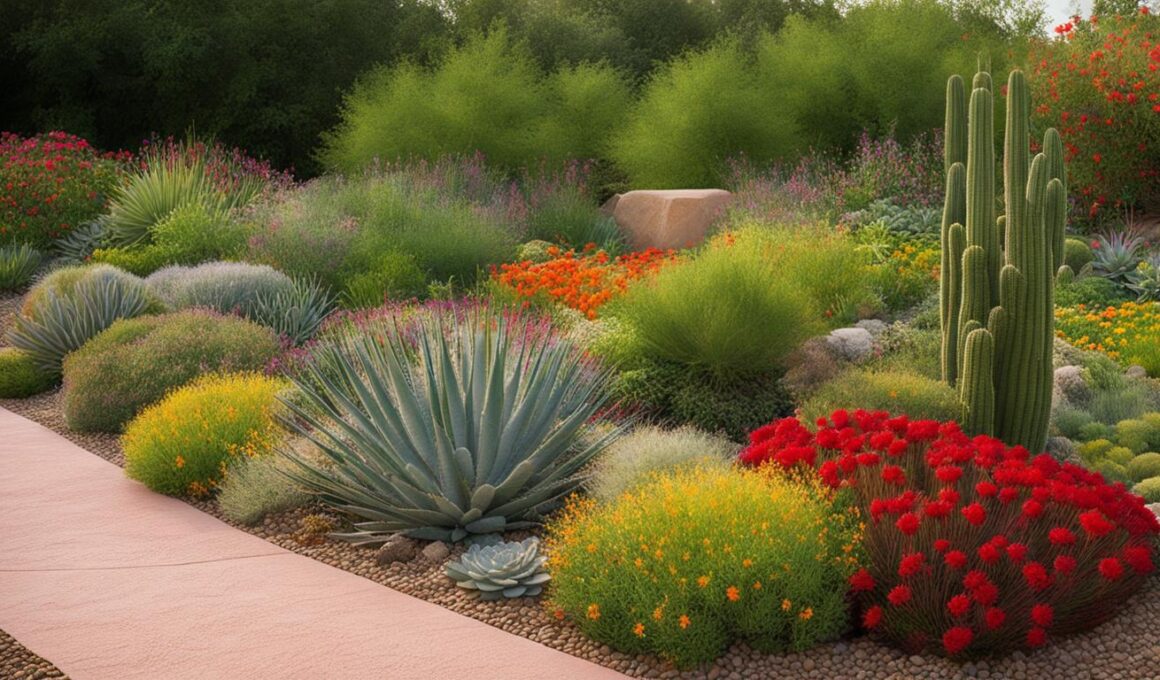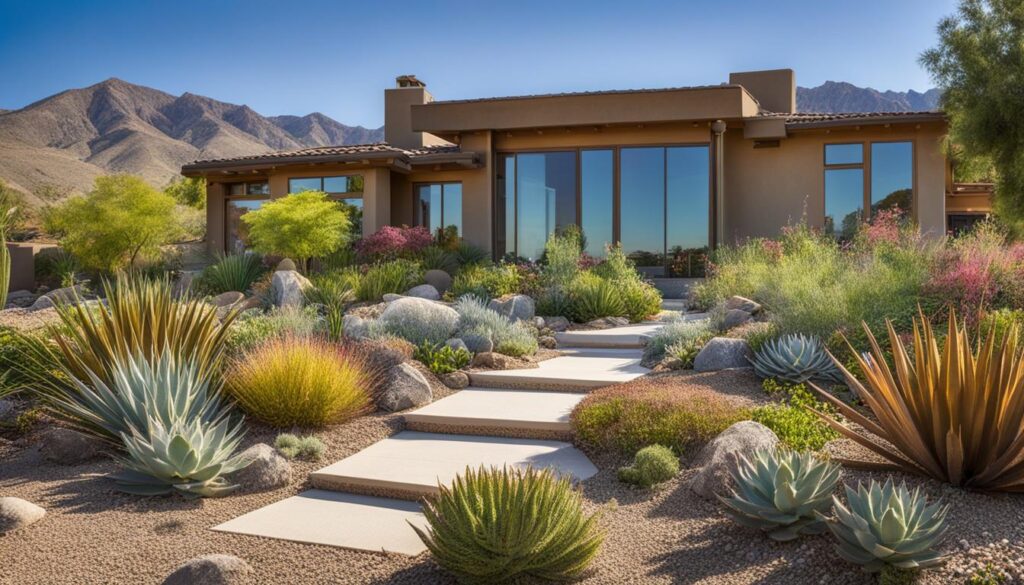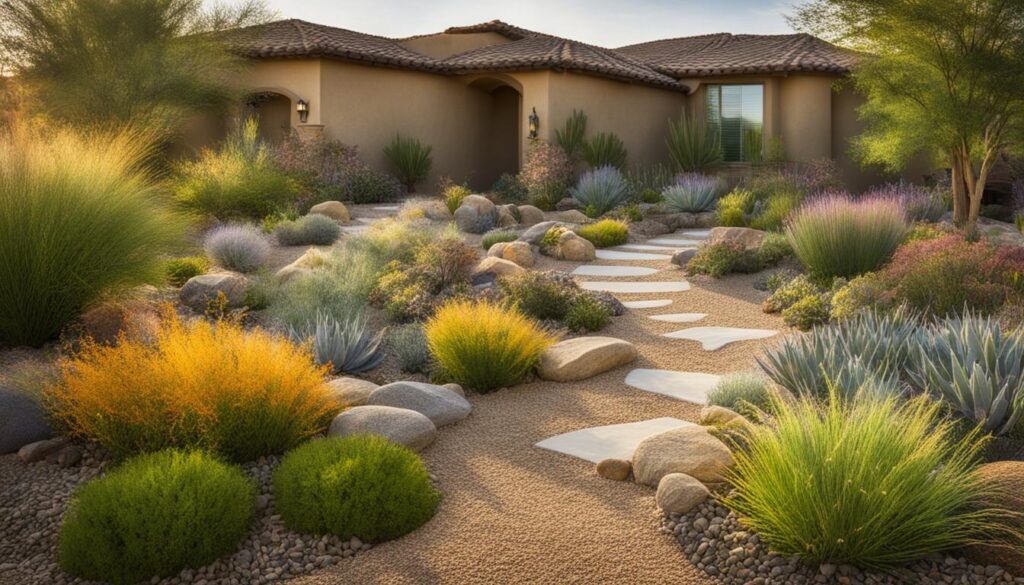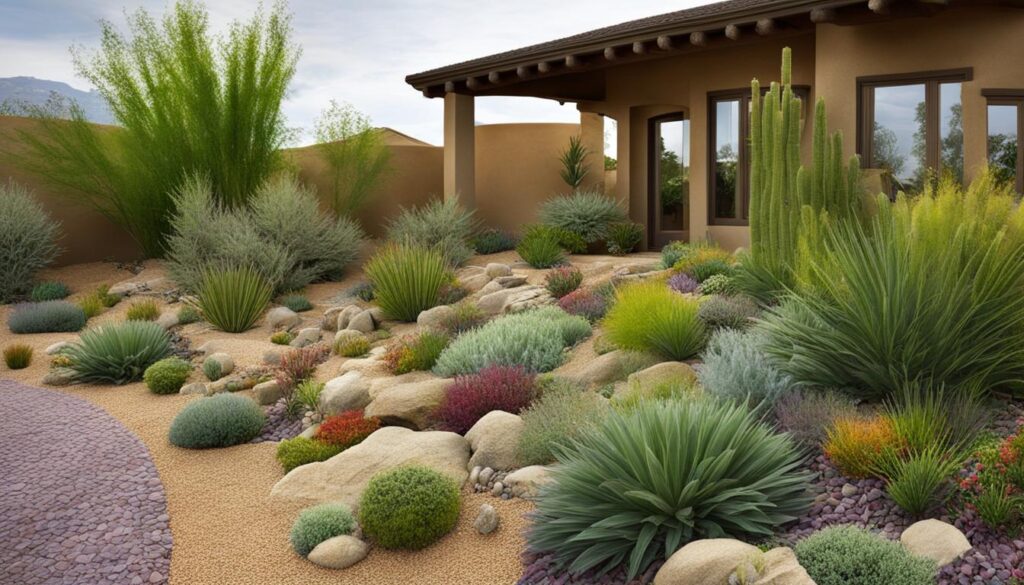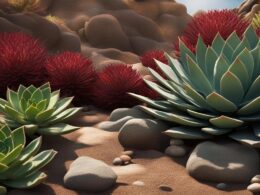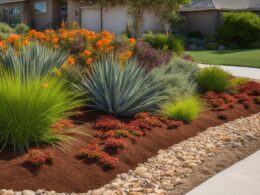Are you considering a new approach to landscaping your home? In this article, we will compare xeriscaping and traditional gardening, giving you valuable insights to help you make an informed decision. Whether you’re looking for a sustainable landscaping option or want to conserve water and reduce maintenance costs, understanding the differences between xeriscaping and traditional gardening is essential.
Key Takeaways:
- Xeriscaping focuses on using native plants and requires less water than traditional gardening.
- Consider factors such as climate, water bill, preferred plants, and landscaping preferences when choosing between xeriscaping and traditional gardening.
- Xeriscaping offers environmental benefits like water conservation, reduced pollution, and energy savings.
- Cost savings can be achieved through lower water bills and reduced maintenance costs with xeriscaping.
- Xeriscaping can create a visually appealing landscape with drought-friendly plants and a low-maintenance garden.
Factors to Consider When Choosing Xeriscaping or Traditional Gardening
When deciding between xeriscaping and traditional gardening, there are several factors you should take into consideration. First and foremost, consider the climate in your area. Xeriscaping is best suited for regions with limited water resources or water restrictions. It thrives in dry, arid climates and can withstand periods of drought, making it an ideal choice for water-conscious homeowners.
Your water bill is another important factor to consider. With xeriscaping, you can significantly reduce your water usage and consequently lower your monthly water bill. Xeriscaped landscapes require less frequent irrigation and can survive on natural rainfall, cutting down on the need for excessive watering.
Another aspect to think about is your preferred plants and overall landscaping preferences. Xeriscaping typically involves using native plants that are well adapted to the local climate. These plants are not only more resistant to drought but also require less maintenance compared to non-native species. However, if you have a specific plant or flower that you are particularly fond of and it doesn’t fit into the xeriscaping concept, traditional gardening may be a better option for you.
Ultimately, the decision between xeriscaping and traditional gardening will depend on your unique circumstances and priorities. Consider the climate, the potential water savings reflected in your bill, and your personal landscaping preferences to make an informed choice that suits your needs.
Environmental Benefits of Xeriscaping
Xeriscaping offers numerous environmental benefits that make it a sustainable landscaping choice for homeowners. By conserving water through the use of native plants that require less irrigation, xeriscaping plays a crucial role in water conservation efforts. Native plants have adapted to the local climate, reducing the need for excessive watering and ensuring long-term sustainability.
In addition to water conservation, xeriscaping also helps reduce pollution. Traditional gardening often requires the use of chemicals and fertilizers, which can leach into the soil and water sources, causing harm to the environment. With xeriscaping, less water usage means fewer chemicals and fertilizers are needed, contributing to a cleaner and healthier ecosystem.
Xeriscaping can also lead to energy savings. By incorporating shade trees and shrubs into the landscape design, xeriscaping helps to reduce the need for cooling in warmer months. The strategic placement of these plants can provide natural shade and cooling, resulting in lower energy consumption and reduced carbon emissions.
Benefits of Xeriscaping:
- Water conservation through the use of native plants adapted to local climate
- Reduced pollution by minimizing the need for chemicals and fertilizers
- Energy savings by incorporating shade trees and shrubs
- Enhanced biodiversity by providing habitats for native wildlife
- Reduced erosion and soil degradation through proper water management
“Xeriscaping not only helps homeowners save water and reduce their environmental impact but also creates a beautiful and sustainable landscape.” – John Smith, Landscaping Expert
Overall, xeriscaping offers a holistic approach to landscaping that benefits both homeowners and the environment. By implementing water-efficient practices and using native plants, xeriscaped gardens can thrive while minimizing the ecological footprint. Embracing xeriscaping can contribute to a greener and more sustainable future.
Cost Savings of Xeriscaping
Xeriscaping offers numerous cost-saving benefits for homeowners. By implementing this sustainable landscaping technique, you can experience significant savings in various aspects of your outdoor maintenance. Here are some key ways that xeriscaping can help you save money:
- Reduced Water Bill: One of the main advantages of xeriscaping is its water efficiency. By using native plants that are adapted to your region’s climate, xeriscaping requires less irrigation compared to traditional gardening. This can result in a significant decrease in your water bill, allowing you to save money each month.
- Lower Maintenance Costs: Xeriscaped landscapes are designed to be low-maintenance, requiring less time, effort, and resources to maintain than traditional gardens. With fewer lawn mowing sessions, less pruning, and minimal need for fertilizers and pesticides, you can cut down on your overall maintenance expenses.
- Increased Property Values: Xeriscaping can enhance the curb appeal of your home and increase its market value. Studies have shown that properties with well-designed xeriscapes can see an increase in value of up to 15%. This means that not only can you enjoy a beautiful and sustainable landscape, but you can also make a sound financial investment.
By implementing xeriscaping techniques, you can achieve significant cost savings while still enjoying a beautiful, environmentally-friendly outdoor space. Whether it’s through reduced water bills, lower maintenance costs, or increased property values, xeriscaping is a financially beneficial choice for homeowners.
The Beauty of Xeriscaping
Xeriscaping may not conjure up images of lush green gardens and vibrant flowers, but don’t be fooled – it can be just as visually stunning as traditional gardens. By incorporating drought-friendly plants and thoughtful design elements, xeriscaping can enhance the curb appeal of your home while still conserving water and promoting sustainability.
One of the key advantages of xeriscaping is its ability to create a low-maintenance garden. With the right selection of drought-tolerant plants, you can enjoy a beautiful landscape without the constant need for watering and upkeep. Imagine spending less time on maintenance tasks and more time simply enjoying your outdoor space.
When it comes to selecting plants for xeriscaping, the options are diverse and exciting. From vibrant succulents to ornamental grasses, there is a wide range of drought-friendly plants that can add texture, color, and visual interest to your xeriscape garden. These plants have adapted to thrive in arid conditions, allowing you to create a unique and eye-catching landscape that stands out in your neighborhood.
Whether you opt for a minimalist design or embrace a more eclectic approach, xeriscaping can provide you with endless possibilities for creating a visually appealing outdoor space. By choosing low-maintenance plants, incorporating hardscape elements such as rocks and gravel, and adding focal points like sculptures or water features, you can achieve a xeriscape garden that is both aesthetically pleasing and environmentally friendly.
Why Choose Xeriscaping for Your Home?
“Xeriscaping can create a visually appealing landscape despite the misconception that it lacks lushness.”
With xeriscaping, you can have a beautiful garden that aligns with your sustainable values. By choosing drought-friendly plants and implementing water-smart design techniques, you can enjoy a low-maintenance garden that not only saves water but also enhances the overall beauty of your outdoor space. So why not consider xeriscaping for your home and create a garden that is both captivating and eco-friendly?
Is Xeriscaping a More Cost-Effective Option Compared to Traditional Gardening for Your Home?
Xeriscaping is a more cost-effective option compared to traditional gardening for your home. By creating a budget-friendly xeriscape garden, you can save money on water usage and maintenance, as xeriscapes require less irrigation and upkeep. Additionally, xeriscaping can also increase property value and provide a low-maintenance, beautiful landscape for your home.
Xeriscaping vs. Zeroscaping: Key Differences
When it comes to low-water landscaping techniques, two popular options are xeriscaping and zeroscaping. While both methods aim to conserve water, there are key differences that set them apart.
Xeriscaping embraces the use of native plants and requires some water, albeit minimal, to create a visually appealing landscape. This approach allows for the inclusion of low-water plants that are well-suited to the local climate, adding beauty and diversity to the garden.
On the other hand, zeroscaping primarily consists of gravel yards with little to no plants. It focuses on creating a low-maintenance landscape that requires no irrigation. Zeroscaping is often seen in arid regions where water resources are extremely limited, or in areas where homeowners prefer a more minimalist aesthetic.
While xeriscaping offers more design options and plant inclusion, zeroscaping provides a more simplified and low-maintenance alternative. Ultimately, the choice between xeriscaping and zeroscaping depends on your personal preferences, the climate in your region, and the level of water conservation you wish to achieve.
“Xeriscaping embraces the use of native plants and requires some water, albeit minimal, to create a visually appealing landscape.”
Conclusion
Xeriscaping and traditional gardening offer distinct approaches to landscaping, but in the comparison between the two, xeriscaping emerges as a more sustainable choice. With its emphasis on water conservation and eco-friendly practices, xeriscaping proves to be a viable option for homeowners seeking a sustainable landscaping solution.
While traditional gardening has its merits and lush appeal, xeriscaping takes a proactive approach to water management by utilizing native plants that are adapted to the local climate. By using plants that require less irrigation, xeriscaping significantly reduces water consumption, making it a favorable option for regions with limited water resources or water restrictions.
In addition to water conservation, xeriscaping offers cost savings and environmental benefits. Reduced water usage translates to lower water bills, and the minimal upkeep required for xeriscaped landscapes results in lower maintenance costs. Furthermore, xeriscaping reduces pollution as it minimizes the need for chemicals and fertilizers. Additionally, by incorporating shade trees and shrubs, xeriscaping can lead to energy savings, providing an eco-friendly solution for homeowners.
In conclusion, xeriscaping stands out as a sustainable landscaping choice that balances environmental responsibility with visual appeal. By considering factors such as climate, water bill, plant preferences, and personal landscaping style, you can make an informed decision between xeriscaping and traditional gardening, ultimately choosing a landscaping technique that best suits your needs and contributes to a more sustainable future.





